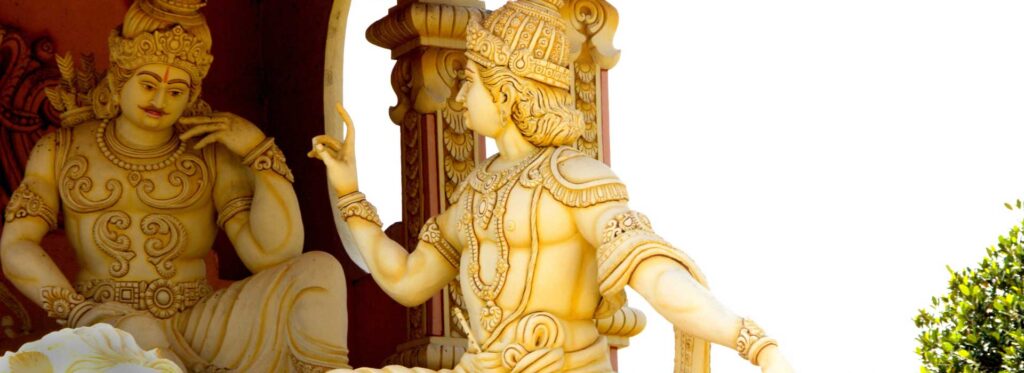
- Home
- Directory
- Events
- Retreat
- Yoga Practices
- Yoga Research
- Wellness Research in Yoga
- Yoga Research on Pandemic
- Yoga Research in Diabetes and Endocrine System
- Yoga Research in Cardiovascular System
- Yoga Research in Depression, Anxiety and Mental Disorders
- Yoga Research in Musculoskeletal System
- Yoga Research in Musculoskeletal System
- Yoga Research in Oncology
- Technology Research and Application in Yoga
- Blog
- Adi Gurus
Paths of Yoga

In Samkhya and Vedanta philosophy, entire creation (Prakriti) is originated from the combination of three Gunas (characteristics/elements) – Tamas, Rajat, and Sattvic. Similar to the material world, the characteristics of a Spiritual aspirant are influenced by the combination of these three guans such that they can be broadly classified into four main psychological types. The nature of aspirants has been related to a specific path/approach to reach the same ultimate spiritual goal.
Path of Yoga | Nature of Aspirant / Spiritual approach |
Bhakti Yoga | Predominantly emotional / Surrender and devotion to God |
Karma Yoga | Physically and mentally active / Selfless devotion to action, renouncing the results of our actions. |
Raja Yoga | The meditative / Control the Mind, seat of all emotions. Path of Meditation |
Jnana Yoga | Predominantly Intellectual. / Yoga of knowledge of Brahman and Atman and the realization of their unity. |
Although these are not airtight demarcation for aspirants, however, such an understanding allows aspirants to follow any path that matched their gunas the best. Each yoga path overlaps the others, allowing aspirants to follow any path in absolute or in a blended manner. Usually, there is one particular path that resonates most, according to a person’s nature.
The Path of Love: Bhakti Yoga
For people with more emotional persona, bhakti yoga is the way for practice. Bhakti yoga, the path of absolute devotion, is the method of merging with Brahman (supermen consciousness). Bhadwad Gita describes this path as the easiest and most direct path to realize the supreme. Absolute devotion and the highest form of love are the cornerstones of this path. All the Acharyas (Teachers) of Bhakti like Kumara(Sanatkumara and others), Vedavyasa, Shukadeva, Shandilya, Garga, Vishnu, Kaundinya, Shesha, Uddhava, Aruni, Bali, Hanuman, Vibhishana, etc., without caring for popular praise or blame, unanimously declare this (that Bhakti is the best path).
The Path of Knowledge: Jnana Yoga
Jnana yoga is the pursuit of divine knowledge, not the worldly knowledge, but the knowledge of Brahman and Atman and the awareness of their unity. The goal is to kindle God’s Bhakti through knowledge and awakening of intellect. Jnana yogis harness the powers of the mind to discriminate between absolute reality and Maya (Purusha and Prakriti) between the permanent and the transient. Jnanis follows non-dualistic or Advaita Vedanta philosophy, also called monists for their affirmation in the sole reality of Brahman. Jnanis consider all duality as ignorance, as the divinity within us is the same as the supreme Brahman, i.e. we ourselves already are divine.
The Path of Work: Karma Yoga
Karma yoga is the yoga of selfless action or work. Karma Yogis are devoted to action, actions in line with their Dharma (the dutiful course). Karma yoga is the path of dedication to work while relinquishing the fruits as a spiritual offering to the almighty. The concepts of success or failure, good or bad, small or big, are the inconsequential outcome of any action. Karma Yogi performs actions with neutrality to all outcomes. Karma yoga is directed to break the bondage and disengage from the ego and sorrow resulting from our actions.
Irrespective of, whether we are devotional, intellectual, or meditative by temperament, karma yoga can easily be practiced in tandem with the other spiritual paths. Karma yoga is effective in converting our routine, mundane life into selfless devotion to God 24×7.
Raja Yoga – the yoga of meditation
Raja yoga is the royal path of meditation. In this path, one strives to rule the domain of mind just as a king maintains control over his kingdom. In raja yoga, we use our mind (manas) to realize the ‘Sat-chi-ananda’. Raj Yoga practice focuses on control and cessation of disturbances of the mind (Chitta Vrittis). The stillness of mind leads to the connection with supreme reality. The mind is cleansed and made tranquil through the repeated practice of meditation and through the practice of divine virtues.
Raj yoga does not suggest a total renunciation of the worldly life, but suggests a path to orient all aspects of our life toward spiritual practices and attaining the goal of God-realization.
As these paths point in the same direction, one goal of oneness with almighty and reaching the Brahman. One can free from the bondage of life and rebirth by following any of these paths, either by work (Karmayoga), or worship (Bhaktiyoga), or mind control (Rajyoga), or intellect (Janaayoga).Crittis). Stillness of mind leads to the connection with supreme reality. The mind is cleansed and made tranquil through the repeated practice of meditation and through the practice of divine virtues.
Raj yoga does not suggest total renunciation of the worldly life, but suggest a path to orient all aspects of our life toward spiritual practices and attaining the goal of God-realization.
As these paths point in the same direction, one goal of oneness with almighty and reaching the Brahman. One can free from bondage of life and rebirth by following any of these path, either by work (Karmayoga), or worship (Bhaktiyoga), or mind control (Rajyoga), or intellect (Janaayoga).